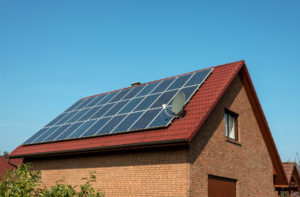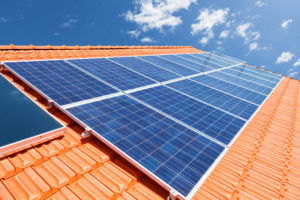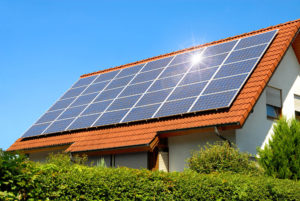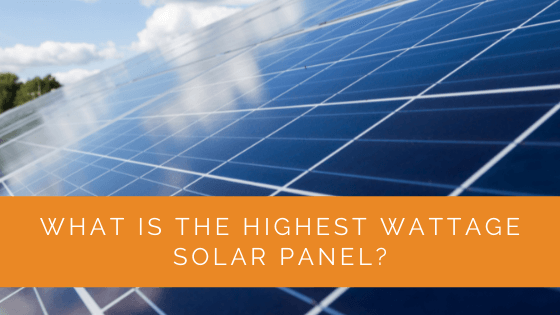As solar equipment is catching more eyes, the race for the highest wattage solar panels continues. The benefits of the solar industry and solar cell technology are immense: You get very eco-friendly, reliable, and efficient solar panels in real-world conditions, along with the fact that prices are pretty cost-effective.
Solar panel manufacturers have been working on technological advancements in high-watt solar panels for a while now. This article will look at how panel wattage matters and the nitty-gritty of the solar energy system.
Contents
- 1 Key Takeaways
- 2 Maximum Wattage Solar Panels
- 3 Which Manufacturers Produce 500-Watt Solar Panels?
- 4 What Are the Benefits of High-Wattage Solar Panels?
- 5 High Watt Solar Panels Comparison
- 6 High Watt Solar Panels and Inverters
- 7 Will the Wattage for These Solar Panels Keep on Increasing?
- 8 Case Study: Installing High-Wattage Solar Panels
- 9 Expert Insights From Our Solar Panel Installers About the Highest Wattage Solar Panels
- 10 Experience Solar Excellence with Us!
- 11 Wrapping Up
Key Takeaways
- The market now features commercial solar panels with a remarkable 700 watts. The most powerful solar panels offer around 500 watts of power for residential applications.
- Leading manufacturers of 500-watt solar panels include Trina Solar and JinkoSolar, offering high module efficiency and power outputs.
- High-wattage solar panels offer greater efficiency and require fewer panels for the same power generation, but they can be expensive and may have space limitations, making careful consideration essential for installation.
Maximum Wattage Solar Panels
The highest-wattage solar panels available on the market have reached impressive new levels. Solar panels offer up to 700 watts of power for commercial use. These panels typically consist of 144 half-cut solar cells designed to maximize power output while minimizing resistance. These high-wattage panels are primarily intended for applications such as solar farms and large-scale business installations.
In the residential sector, the maximum wattage for solar panels is around 500 watts. This limitation is largely due to the need to ensure the panels are suitably sized for most residential rooftops. The increase in wattage for both commercial and residential solar panels has been achieved through various methods, including increasing the size of the panels to accommodate more solar cells, reducing the size of the cells themselves (allowing for more half-cut solar cells on the same panel size), and employing bifacial solar panels that generate electricity from both sides.
Which Manufacturers Produce 500-Watt Solar Panels?
If you want to buy a 500-watt solar panel with a high module efficiency, you can look at some leading manufacturers. Two of them are mentioned below:
Trina Solar
As mentioned previously, this Chinese manufacturer of solar panel kits and solar power products has been producing very high-powered bifacial solar panels for a while now. As of now, they have two main lines for bifacial panels, namely, Tallmax and Duomax.
These solar panels have a power output of about 500 watts and are helpful for large, high utility solar installation.
JinkoSolar
The Jinkosolar company has started producing a 500-watt solar panel with their Tiger Pro Series. They are world-renowned with both commercial and residential solar spaces.
The 500-watt model has a 585-watt power output with 21.4% efficiency.

What Are the Benefits of High-Wattage Solar Panels?
One of the most significant advantages of opting for a higher wattage panel is its higher efficiency. Not just that, you also get maximum output compared to lower-watt solar panels. These factors remain the same for all modules.
A 50 wattage difference will have a particular efficiency difference in the efficiency. As the difference in wattage increases, so will the change in efficiency loss. Additionally, if you have a higher power generation, you will require lesser modules along with reduced equipment to finalize the entire solar project.
Let us look at these facts in terms of calculations!
For instance, 1000 kWh/ month average equals to 12,000 kWh/ year
12,000 kWh/year/365 days/4.5 peak sun hours/ 0.82 degradation rate amounts to about 6kW system
- 6000 watts/ 350 watts = 17.14 solar panels
- 6000 watts/ 400 watts = 15 solar panels
You can use these high-wattage solar panels for those installation sites that have a limited roof space. As a rule of thumb, the most efficient solar panels have 72 cells, or 144 half cut ones, compared to 60 cells or 120 half cut ones.
As the cell number rises, the height of the solar panel increases by 8 to 10 inches in contrast to the 60 cell panels on average. You should keep the probable shape and size in mind along with the space you are concerned with before making a decision.
Wouldn’t want the highly efficient panel with a worth noting working not to fit your small roof? Would you?
While there are benefits of high solar output, the negative is that such a solar panel system is pretty expensive. Only certain brands will be able to produce them, and this reduction in supply thereby increases the prices to the next level.
As the popularity amongst consumers increases for the solar industry, you will experience specific supply and demand issues.
High Watt Solar Panels Comparison
The higher watt solar panels can be compared based on some critical factors. Below are mentioned some of them!
The main factors to keep in mind are the Maximum Power Output, warranty period, Efficiency rate, and Degradation rate with the 25-year output.
In general, the efficiency rating and the Maximum Power output are representative of the amount of total energy produced from the solar modules. Moreover, the majority of the solar panel manufacturers provide at least a 25-year extended linear performance warranty.
This warranty provides the output for the solar panel, which is based on the modules degradation rate. On average, most solar panels have a product warranty of 10 years; on the other hand, some solar power system manufacturers provide a warranty for 25 years.
The consideration of the degradation rate is pretty important as well. This factor shows the power ratings for the individual panel or solar watt panels at the end of the warranty period. The solar watt panels will continue to work after this time, but the overall efficiency will be similar to the degradation rate mentioned.

High Watt Solar Panels and Inverters
The choice of inverters for the best solar panels, such as microinverters, hybrid inverters, or string inverters, will work just like the lower watt modules. When you are using high watt modules in the case of an off-grid setup, it is particularly essential to spec out the charge controller in the right way.
Most off-grid systems use high-watt modules increasing to 2 kilowatts according to the charge controller and the battery backup stem that the user is utilizing.
Here, we will mainly look at the String Inverters. These inverters are the most cost-efficient inverter solution in the market for all the on-grid solar energy systems. The string inverters can be paired with a battery backup and other AC-coupled systems.
The only negative is that the equipment can be tricky to handle. Moreover, it is suggested that professionals should install the inverter systems only.
Will the Wattage for These Solar Panels Keep on Increasing?
On a general note, two main ways can make solar watt panels even more robust. They are, firstly, increasing the efficiency or increasing their physical size. The most efficient solar panels are usually maxed out at 23 perc cells.
In the case of a standard residential size panel, this would refer to the 425 watts. On the contrary, with every half percentage point that the efficiency of the panel would increase, there would be more power by 10 watts.
This efficiency level would have been close to impossible a few years back. Now, if we see residential panels increase by another five per cent to about 28 per cent, which would produce 525-watt panels.
Instead of these factors, you might see the solar panels increase from 60 to 72 cells, which would result in more extensive solar panels that would need more space. They would have a higher power rating, panel efficiency, energy output, but you might end up storing them in solar farms rather than the less space in your house.
Another negative of this new technology would lead to additional costs, high manufacturing costs, system design, and integration problems with more significant and high-weighted modules.

Case Study: Installing High-Wattage Solar Panels
Background
At Solar Panels Network USA, our mission is to provide cutting-edge solar energy solutions tailored to meet the evolving needs of our clients. This case study highlights a recent residential project in Charleston, South Carolina, where we installed high-wattage solar panels to maximize energy production and efficiency.
Project Overview
Our client, a homeowner in Charleston, wanted to significantly reduce their electricity bills and carbon footprint. They sought a high-efficiency solar solution that could fit within the limited roof space of their historic home. The objective was to install a solar panel system with the highest possible wattage to ensure maximum energy output.
Implementation
Site Assessment and Preparation
We conducted a thorough site assessment, examining the roof’s condition, orientation, and potential shading issues. Charleston’s coastal climate was also considered to ensure the panels would perform optimally year-round. The roof’s south-facing orientation and good condition made it ideal for solar installation.
Selection of Solar Panels
Given the client’s requirements and the roof’s constraints, we selected high-wattage 300-watt solar panels. These panels were chosen for their superior efficiency and ability to generate substantial power from a smaller number of panels, fitting perfectly within the available space.
Installation Process
- Mount Installation We used robust, corrosion-resistant mounts to ensure the panels’ stability and durability. These mounts were positioned to maximize sunlight exposure and withstand Charleston’s coastal weather conditions.
- Panel Installation The high-wattage panels were carefully aligned and securely fastened to the mounts. This step was crucial for ensuring long-term performance and safety, particularly in high wind conditions typical of coastal areas.
- Electrical Wiring Utilizing universal connectors, we ensured reliable electrical connections between the panels and the inverter. We employed a series connection to enhance the system’s voltage and overall efficiency.
- Connecting to Inverter and Grid The system was connected to a high-efficiency solar inverter, which was then integrated with the home’s electrical system. This setup allowed for net metering, enabling the homeowner to feed excess energy back into the grid and receive credits on their electricity bill.
- System Activation After installation, the system was rigorously tested to ensure optimal performance. The client was provided with detailed instructions on monitoring and maintaining the system to ensure continued efficiency.
Results
The installation was completed seamlessly, and the system began generating power immediately. The homeowner reported a significant reduction in their electricity bills, with an estimated annual savings of 35%. The high-wattage panels’ efficiency ensured that even during periods of lower sunlight, the system continued to perform optimally.
The project demonstrated the effectiveness of high-wattage panels in residential settings, especially where roof space is limited. The client was particularly pleased with the system’s performance and the noticeable decrease in their energy costs.
Summary
This case study illustrates how high-wattage solar panels can be effectively utilized in residential installations to maximize energy production and efficiency. By leveraging the latest advancements in solar technology, we provided our client in Charleston with a sustainable, cost-effective solution that significantly reduced their energy expenses and carbon footprint. Our commitment to quality and innovation continues to drive our efforts in delivering top-tier solar energy solutions across South Carolina.
Expert Insights From Our Solar Panel Installers About the Highest Wattage Solar Panels
High-wattage solar panels offer significant advantages in efficiency and power output, which translates to fewer panels needed for the same energy generation, making them ideal for installations with limited roof space.
Senior Solar Panel Installer
When considering high-wattage panels for residential use, it’s important to balance the cost against the long-term energy savings and efficiency gains. These panels can deliver impressive returns on investment.
Lead Solar Engineer
The advancements in solar panel technology mean that even higher wattage panels are becoming available, providing more power and efficiency. This trend is likely to continue, driving further adoption of solar energy.
Chief Installation Officer
Experience Solar Excellence with Us!
Trust in Solar Panels Network USA, where our seasoned experts deliver top-quality solar solutions for homes and businesses nationwide. With a legacy of countless successful installations and a commitment to sustainable energy, we’re your reliable partner in the solar journey. Ready for a brighter, eco-friendly future? Call us now at (855) 427-0058 and harness the power of the sun!
Wrapping Up
So, these are some of the things you need to know when you’re looking at high-watt solar panels. Whether you have an entire solar system, some solar cells, or a single solar panel, your power requirements will reduce compared to traditional energy-producing methods. People, do try them out!
About the Author
Solar Panels Network USA stands at the forefront of solar energy solutions, driven by a team of seasoned solar engineers and energy consultants. With over decades of experience in delivering high-quality solar installations and maintenance, we are committed to promoting sustainable energy through customer-centric, tailored solutions. Our articles reflect this commitment, crafted collaboratively by experts to provide accurate, up-to-date insights into solar technology, ensuring our readers are well-informed and empowered in their solar energy decisions.

